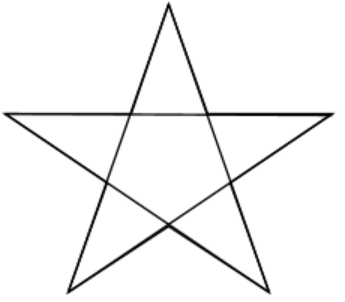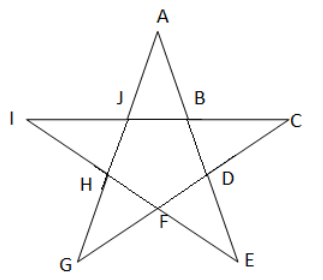
How many triangles are there in the diagram given below?

A. 6
B. 10
C. 12
D. 14

Answer
579.3k+ views
Hint: We will first name all of the vertices of the star and count vertex by vertex how many triangles are there and this will give us our answer.
Complete step-by-step solution:

From the figure, we can see that A, C, E, G, and I are the outer vertices of the figure, and B, D, F, H, and J are the inner vertices of the figure.
Now, starting from vertex A, we can see that there are a total of 5 small triangles which have one vertex as an out vertex of the figure and the other two vertices as the inner vertices of the figure. They are given as:
$\begin{align}
& \Delta AJB \\
& \Delta CBD \\
& \Delta EDF \\
& \Delta GFH \\
& \Delta IJH \\
\end{align}$
Therefore, there are 5 small triangles in the given figure.
Now we will count the big triangles in the figure.
Starting from vertex J, we can see that there are also 5 bigger triangles in this figure which have one vertex as an inner vertex of the figure and the other two vertices as the outer vertices of the figure. They are given as:
$\begin{align}
& \Delta JCG \\
& \Delta BEI \\
& \Delta DGA \\
& \Delta FIC \\
& \Delta HAE \\
\end{align}$
Therefore, there are 5 big triangles in the given figure.
Thus, the total number of triangles in the given figure is:
$\Rightarrow 5+5=10$
Therefore, there are a total of 10 triangles in figure (5 small and 5 big).
Hence, option (B) is the correct option.
Note: Don’t forget to name the vertices as it is very important in this type of question. Always name the vertices of the figure and count the triangles in reference to the unique vertex. It decreases the scope of mistakes and results in the most accurate answer.
Complete step-by-step solution:

From the figure, we can see that A, C, E, G, and I are the outer vertices of the figure, and B, D, F, H, and J are the inner vertices of the figure.
Now, starting from vertex A, we can see that there are a total of 5 small triangles which have one vertex as an out vertex of the figure and the other two vertices as the inner vertices of the figure. They are given as:
$\begin{align}
& \Delta AJB \\
& \Delta CBD \\
& \Delta EDF \\
& \Delta GFH \\
& \Delta IJH \\
\end{align}$
Therefore, there are 5 small triangles in the given figure.
Now we will count the big triangles in the figure.
Starting from vertex J, we can see that there are also 5 bigger triangles in this figure which have one vertex as an inner vertex of the figure and the other two vertices as the outer vertices of the figure. They are given as:
$\begin{align}
& \Delta JCG \\
& \Delta BEI \\
& \Delta DGA \\
& \Delta FIC \\
& \Delta HAE \\
\end{align}$
Therefore, there are 5 big triangles in the given figure.
Thus, the total number of triangles in the given figure is:
$\Rightarrow 5+5=10$
Therefore, there are a total of 10 triangles in figure (5 small and 5 big).
Hence, option (B) is the correct option.
Note: Don’t forget to name the vertices as it is very important in this type of question. Always name the vertices of the figure and count the triangles in reference to the unique vertex. It decreases the scope of mistakes and results in the most accurate answer.
Recently Updated Pages
Two men on either side of the cliff 90m height observe class 10 maths CBSE

What happens to glucose which enters nephron along class 10 biology CBSE

Cutting of the Chinese melon means A The business and class 10 social science CBSE

Write a dialogue with at least ten utterances between class 10 english CBSE

Show an aquatic food chain using the following organisms class 10 biology CBSE

A circle is inscribed in an equilateral triangle and class 10 maths CBSE

Trending doubts
Why is there a time difference of about 5 hours between class 10 social science CBSE

Write a letter to the principal requesting him to grant class 10 english CBSE

What is the median of the first 10 natural numbers class 10 maths CBSE

The Equation xxx + 2 is Satisfied when x is Equal to Class 10 Maths

Which of the following does not have a fundamental class 10 physics CBSE

State and prove converse of BPT Basic Proportionality class 10 maths CBSE




